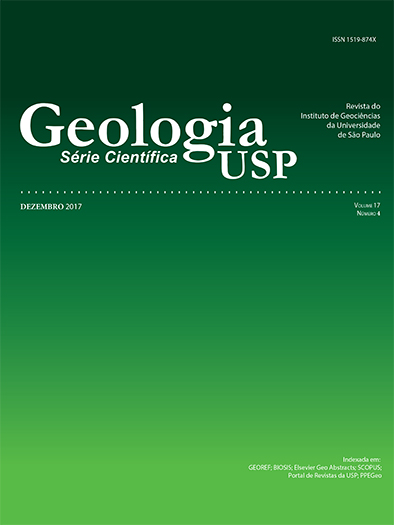Faciologia orgânica da Formação Romualdo (Grupo Santana, Cretáceo Inferior da Bacia do Araripe): caracterização da matéria orgânica sedimentar e interpretação paleoambiental
DOI:
https://doi.org/10.11606/issn.2316-9095.v17-347Palavras-chave:
Bacia do Araripe, Formação Romualdo, Matéria orgânica sedimentar, Palinofácies, PaleoambienteResumo
A reconstrução paleoambiental do Grupo Santana (Neoaptiano-Eoalbiano) é matéria ainda controversa, principalmente no que se refere à influência marinha na sedimentação. Nesse contexto, a análise de palinofácies pode ser utilizada como ferramenta na caracterização de sistemas deposicionais, por meio da determinação de parâmetros palinofaciológicos e organogeoquímicos, baseados na concentração e distribuição dos componentes da matéria orgânica. No presente estudo foram utilizadas técnicas de microscopia em luz branca transmitida e azul/ultravioleta incidente (fluorescência) e métodos geoquímicos para a identificação dos diferentes grupos e subgrupos da matéria orgânica particulada em 58 amostras de uma seção sedimentar da Formação Romualdo (Grupo Santana, Cretáceo Inferior da Bacia do Araripe). As análises permitiram verificar a existência de duas assembleias distintas de componentes orgânicos particulados. A primeira é caracterizada por dominância de matéria orgânica amorfa derivada de tecidos vegetais, com quantidades relativamente elevadas de componentes de origem marinha. A segunda assembleia é caracterizada por dominância do Grupo Fitoclasto, predominando o subgrupo do fitoclasto não opaco não bioestruturado. A subdivisão do perfil litológico estudado em cinco intervalos estratigráficos possibilitou identificar ciclicidade no padrão de suprimento do material orgânico, relacionada a oscilações do nível relativo do mar. Dentre os intervalos estratigráficos identificados, constatou-se indícios da ocorrência de pelo menos duas ingressões marinhas durante a deposição da Formação Romualdo. A primeira marca o estabelecimento de condições relativamente estáveis de deposição da matéria orgânica, sob fácies de caráter mais distal a intermediário, em ambiente de mar epicontinental. A segunda ingressão marinha apresenta tendência de deposição da matéria orgânica sedimentar em condições proximais, mas com elevada influência de componentes de origem marinha, evidenciando um ambiente transicional proximal-distal, possivelmente um ambiente marinho costeiro.
Downloads
Publicado
Edição
Seção
Licença
Autores que publicam nesta revista concordam com os seguintes termos:
- Autores mantém os direitos autorais e concedem à revista Geologia USP. Série Científica, o direito de primeira publicação, com o trabalho sob a licença Creative Commons BY-NC-SA (resumo da Licença: https://creativecommons.org/licenses/by-nc-sa/4.0 | texto completo da licença: https://creativecommons.org/licenses/by-nc-sa/4.0/legalcode) que permite o compartilhamento do trabalho de forma não comercial e conferindo os devidos créditos autorais da primeira publicação nesta revista.
- Autores têm autorização para assumir contratos adicionais separadamente, para distribuição não-exclusiva da versão do trabalho publicada nesta revista (publicar em repositório institucional ou como capítulo de livro), conferindo os devidos créditos autorais da primeira publicação nesta revista.
- Autores têm permissão e são estimulados a publicar e distribuir seu trabalho online (em repositórios institucionais ou na sua página pessoal) a qualquer ponto antes ou durante o processo editorial, uma vez que isso pode gerar alterações produtivas, bem como aumentar o impacto e a citação do trabalho publicado (Veja O efeito do Acesso Aberto e downloads no impacto das citações).















